Procter & Gamble Bundle
How Does Procter & Gamble Conquer the Consumer Market?
Procter & Gamble (P&G), a global behemoth, has shaped daily life for generations, but how does this consumer goods giant actually work? From its humble beginnings in 1837, the Procter and Gamble company has grown into a multinational powerhouse, consistently delivering essential products to billions worldwide. Understanding P&G's operations is key for anyone interested in the consumer market and investment opportunities.
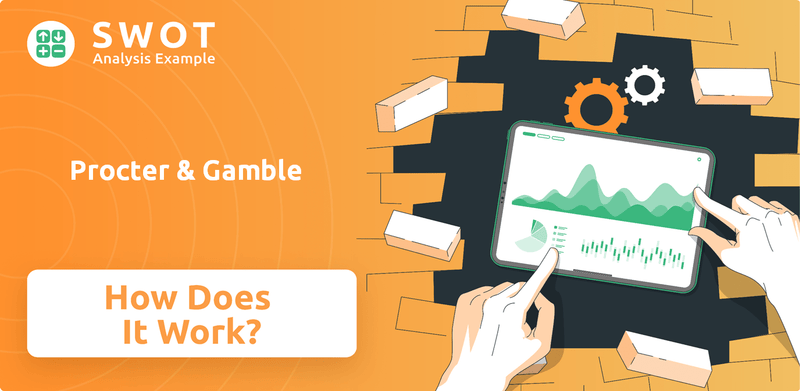
This exploration into the Procter & Gamble SWOT Analysis will reveal the inner workings of P&G, examining its extensive brand portfolio and intricate supply chain. We'll dissect its business model, exploring how P&G manufactures products, distributes them globally, and maintains its competitive edge. Discover how this industry leader leverages innovation, marketing strategies, and sustainability initiatives to remain a dominant force in the consumer goods sector, and its financial performance.
What Are the Key Operations Driving Procter & Gamble’s Success?
Procter & Gamble (P&G) creates value by offering a wide range of essential consumer goods. Its core business revolves around a diverse brand portfolio that addresses daily needs across various demographics. These products span key segments such as Beauty, Grooming, Health Care, Fabric & Home Care, and Baby, Feminine & Family Care.
The operational structure of the Procter and Gamble company is extensive and highly integrated. It encompasses advanced manufacturing facilities, sophisticated global sourcing networks, and continuous research and development. The company's focus on innovation and its commitment to quality are central to its value proposition.
P&G's supply chain is a critical component of its operational excellence, designed for efficiency and responsiveness to global demand. This includes working with major retailers, e-commerce platforms, and local distributors. Its commitment to economies of scale allows for cost-effective production. P&G's investment in digital transformation, including optimizing its supply chain with AI and machine learning, further enhances its operational efficiency and resilience.
P&G's primary product segments include Beauty, Grooming, Health Care, Fabric & Home Care, and Baby, Feminine & Family Care. These segments cater to a broad consumer base with a wide variety of products. The brand portfolio is designed to meet diverse consumer needs globally.
P&G's supply chain is a key factor in its operational success. The company leverages a vast network of manufacturing plants, distribution centers, and retail partnerships. This ensures products are readily available to consumers worldwide.
P&G employs a decentralized brand management approach, enabling agile responses to local market nuances. This approach allows brands to adapt to specific consumer preferences. This approach benefits from global insights and resources.
P&G invests heavily in digital transformation to enhance operational efficiency. This includes optimizing its supply chain with AI and machine learning. These technologies improve responsiveness and reduce costs.
P&G's operational excellence is driven by its robust supply chain, economies of scale, and brand management strategies. The company's focus on innovation and digital transformation further enhances its capabilities. These strengths enable P&G to maintain a competitive edge in the consumer goods market.
- Global Reach: P&G operates in over 70 countries, with products sold in over 180 countries.
- Innovation: P&G invests heavily in R&D, with spending of over $2 billion annually to develop new products and improve existing ones.
- Financial Performance: In fiscal year 2024, P&G reported net sales of approximately $82 billion.
- Market Leadership: P&G holds leading market positions in many of its product categories, due to its strong brand equity and consistent product performance. For more insights, check out the Growth Strategy of Procter & Gamble.
Procter & Gamble SWOT Analysis
- Complete SWOT Breakdown
- Fully Customizable
- Editable in Excel & Word
- Professional Formatting
- Investor-Ready Format
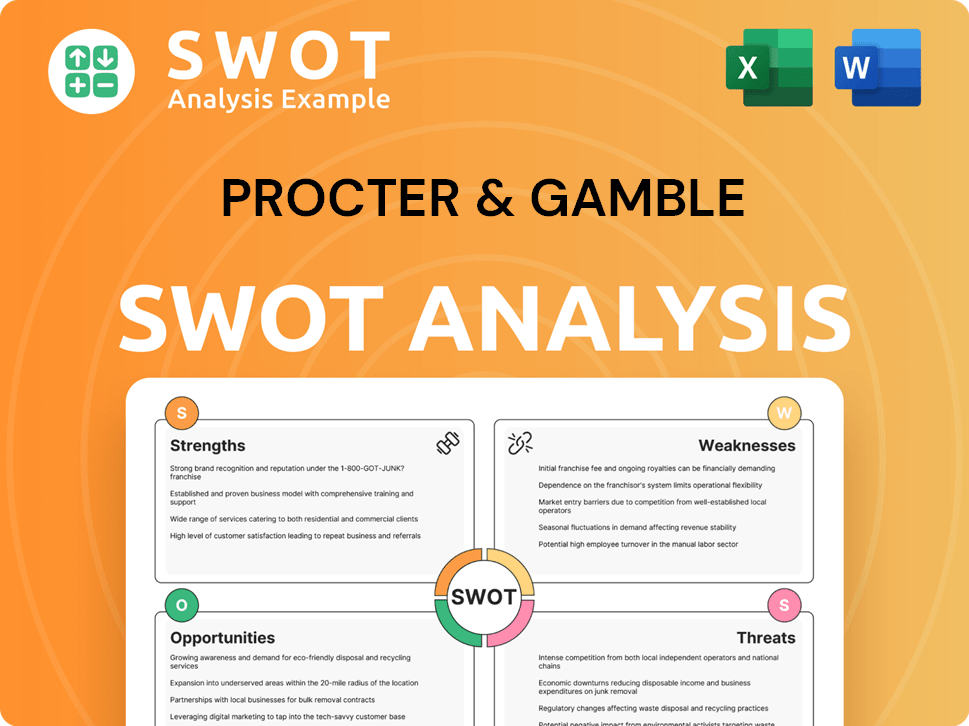
How Does Procter & Gamble Make Money?
The Procter & Gamble (P&G) generates revenue primarily through the sale of its diverse range of branded consumer goods. These products are sold across various segments, each contributing significantly to the company's financial performance. The company's ability to maintain strong sales figures reflects its robust brand portfolio and effective market strategies.
P&G's revenue streams are largely driven by product sales, with a focus on volume and pricing power. The company leverages its extensive distribution networks and strong brand recognition to maintain its market position. This approach is supported by substantial investments in advertising and marketing, which help drive consumer demand and reinforce brand loyalty.
For the second quarter of fiscal year 2024, net sales reached $20.2 billion. The Fabric & Home Care segment was a major contributor, with organic sales increasing by 8% in the first quarter of fiscal year 2024. Other segments also showed strong growth: Beauty organic sales grew by 11%, Grooming by 9%, Health Care by 13%, and Baby, Feminine & Family Care by 11% in the same quarter.
The company employs various pricing strategies, including premium pricing for its leading brands and value-tier options. P&G also uses promotional pricing to stimulate demand. Moreover, the company has expanded its e-commerce presence, with e-commerce sales accounting for 17% of total sales in fiscal year 2023. For more details on how P&G achieves its goals, you can read about the Growth Strategy of Procter & Gamble.
- Product Sales: The core revenue stream is generated from the sale of consumer goods across its brand portfolio.
- Pricing Strategies: Includes premium pricing, value-tier options, and promotional pricing to maximize revenue.
- E-commerce: Expansion into digital channels to capture online sales and adapt to changing consumer behaviors.
- Marketing and Advertising: Investments in advertising and marketing to drive consumer demand and reinforce brand loyalty.
Procter & Gamble PESTLE Analysis
- Covers All 6 PESTLE Categories
- No Research Needed – Save Hours of Work
- Built by Experts, Trusted by Consultants
- Instant Download, Ready to Use
- 100% Editable, Fully Customizable
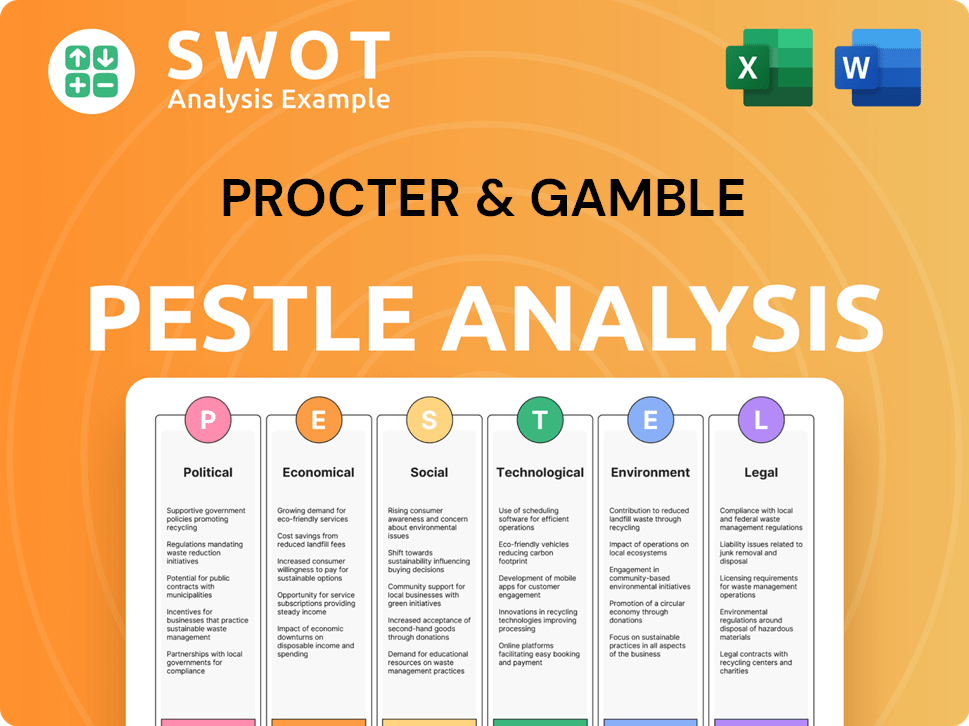
Which Strategic Decisions Have Shaped Procter & Gamble’s Business Model?
The journey of the Procter & Gamble company, often referred to as P&G, has been marked by significant milestones and strategic shifts. These moves have shaped its operational and financial landscape, solidifying its position as a leader in the consumer goods industry. A key element of P&G's strategy involves continuously refining its brand portfolio to enhance profitability and streamline operations.
A pivotal strategy for Procter & Gamble involves focusing on a concentrated portfolio of leading brands. This has included divesting over 100 brands in recent years. This strategic move allows P&G to concentrate resources on its most valuable and growth-oriented brands, improving overall efficiency and market impact. For instance, in 2014, P&G announced plans to divest or discontinue approximately 100 brands to focus on its top 70 to 80 brands.
Operational challenges for Procter & Gamble have included navigating supply chain disruptions. The company has responded by investing in supply chain resilience, leveraging data analytics to optimize inventory management, and diversifying sourcing to mitigate risks. The company's competitive advantages are multifaceted, including brand strength, economies of scale, and robust research and development capabilities.
Procter & Gamble's history includes significant acquisitions and divestitures. These actions have reshaped the company's brand portfolio and market position. For example, the acquisition of Gillette in 2005 expanded P&G's presence in the grooming market. In recent years, P&G has divested numerous brands to focus on its core products, which has impacted its financial performance.
P&G's strategic moves center on brand building, innovation, and supply chain optimization. The company invests heavily in marketing and advertising to maintain brand recognition. Innovation in product development and packaging is also a priority. Furthermore, P&G has focused on improving its supply chain to manage costs and enhance efficiency. You can learn more about P&G's marketing strategies in this article: Marketing Strategy of Procter & Gamble.
Procter & Gamble's competitive edge comes from its strong brand portfolio, economies of scale, and innovation. The company's diverse brand portfolio allows it to cater to a wide range of consumer needs. Its global presence and efficient distribution networks provide a significant advantage. Moreover, P&G's commitment to sustainability and environmentally friendly products is an important factor in its competitive strategy.
P&G's financial performance reflects its strategic focus and market position. The company generates substantial revenue and profits, driven by its leading brands. In fiscal year 2023, P&G reported net sales of approximately $82 billion. P&G's stock performance and dividend payments also reflect its financial stability. The company's ability to adapt to changing market conditions and consumer preferences is critical to its continued success.
Procter & Gamble's competitive advantages are built on several key strengths. These include strong brand recognition, economies of scale, and continuous innovation. These factors enable P&G to maintain its market leadership and deliver value to its shareholders. The company's focus on sustainability and consumer needs also contributes to its competitive edge.
- Brand Strength: P&G's portfolio includes many of the world's most recognized and trusted brands, fostering strong consumer loyalty.
- Economies of Scale: P&G benefits from significant economies of scale in manufacturing, procurement, and distribution, leading to cost efficiencies.
- Innovation: Robust research and development capabilities drive continuous product innovation, ensuring P&G remains at the forefront of consumer preferences.
- Supply Chain Management: P&G has a well-established and efficient supply chain, enabling it to manage costs and ensure product availability.
Procter & Gamble Business Model Canvas
- Complete 9-Block Business Model Canvas
- Effortlessly Communicate Your Business Strategy
- Investor-Ready BMC Format
- 100% Editable and Customizable
- Clear and Structured Layout
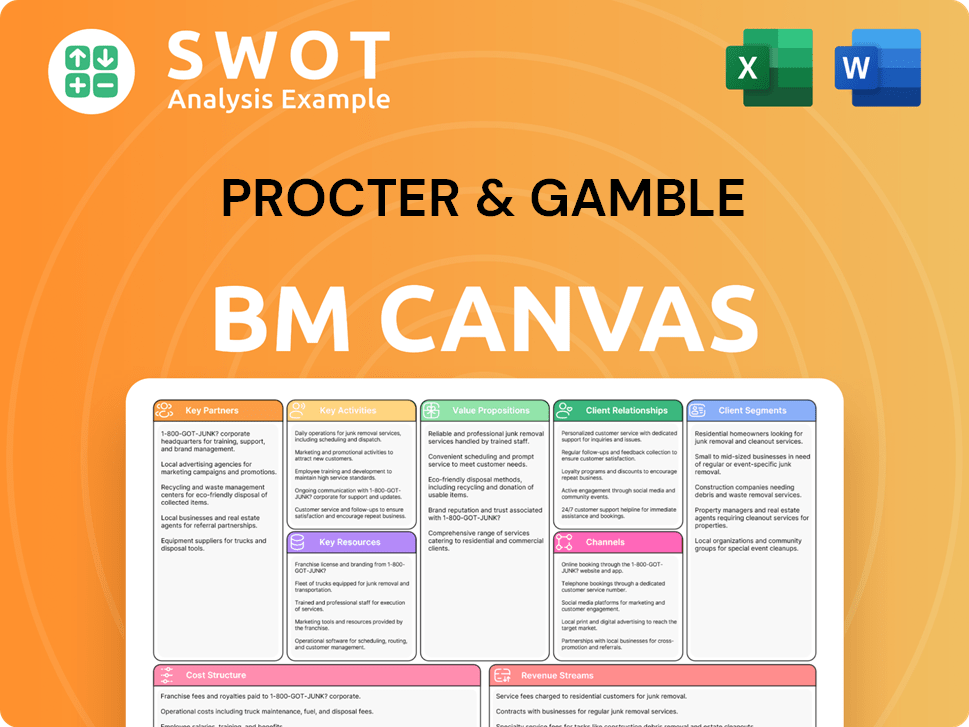
How Is Procter & Gamble Positioning Itself for Continued Success?
The Procter & Gamble (P&G) company holds a leading position in the global consumer goods industry. Its extensive brand portfolio and global distribution network allow it to maintain substantial market share across various product categories. The company's products are sold in over 180 countries and territories, demonstrating its widespread reach and strong customer loyalty.
However, Procter and Gamble company faces several challenges, including intense competition and evolving consumer preferences. Regulatory changes and economic pressures also pose risks. To maintain its competitive edge, P&G focuses on innovation, digital transformation, and sustainability initiatives.
P&G consistently ranks among the top players in the global consumer goods market. Its strong brand recognition and widespread distribution channels contribute to its market leadership. The company's diverse product offerings cater to a broad consumer base worldwide.
P&G faces competition from both established multinationals and agile, direct-to-consumer brands. Regulatory changes, particularly concerning product safety and environmental impact, pose ongoing challenges. Consumer demand for sustainable and personalized products requires continuous innovation.
P&G is focused on strategic initiatives to sustain revenue growth. These include continued investment in product innovation and digital transformation. The company emphasizes responsible growth, focusing on environmental sustainability and social impact. This approach aims to ensure sustained profitability and market leadership.
P&G is prioritizing digital transformation to enhance its e-commerce capabilities and data analytics. The company is also investing in high-growth categories and premium segments. These efforts align with evolving consumer values and market dynamics, ensuring long-term growth.
P&G's strategy involves a multi-faceted approach to drive growth and maintain its market position. This includes focusing on product innovation, enhancing its digital presence, and optimizing its supply chain. The company is also committed to sustainability and responsible business practices.
- Investment in high-growth categories and premium segments.
- Enhancement of e-commerce capabilities and digital marketing.
- Leveraging data analytics for supply chain optimization.
- Commitment to environmental sustainability and social impact.
P&G's commitment to innovation and adaptability is evident in its approach to the market. The company's ability to understand its Target Market of Procter & Gamble and respond to changing consumer needs is crucial for its continued success. In fiscal year 2024, P&G reported net sales of approximately $82 billion, demonstrating its substantial scale and market presence. The company's focus on productivity and constructive disruption, as highlighted in its leadership statements, underscores its commitment to operational efficiency and market agility. Furthermore, P&G's emphasis on responsible growth and sustainability aligns with evolving consumer expectations and regulatory trends, positioning the company for long-term value creation and market leadership.
Procter & Gamble Porter's Five Forces Analysis
- Covers All 5 Competitive Forces in Detail
- Structured for Consultants, Students, and Founders
- 100% Editable in Microsoft Word & Excel
- Instant Digital Download – Use Immediately
- Compatible with Mac & PC – Fully Unlocked
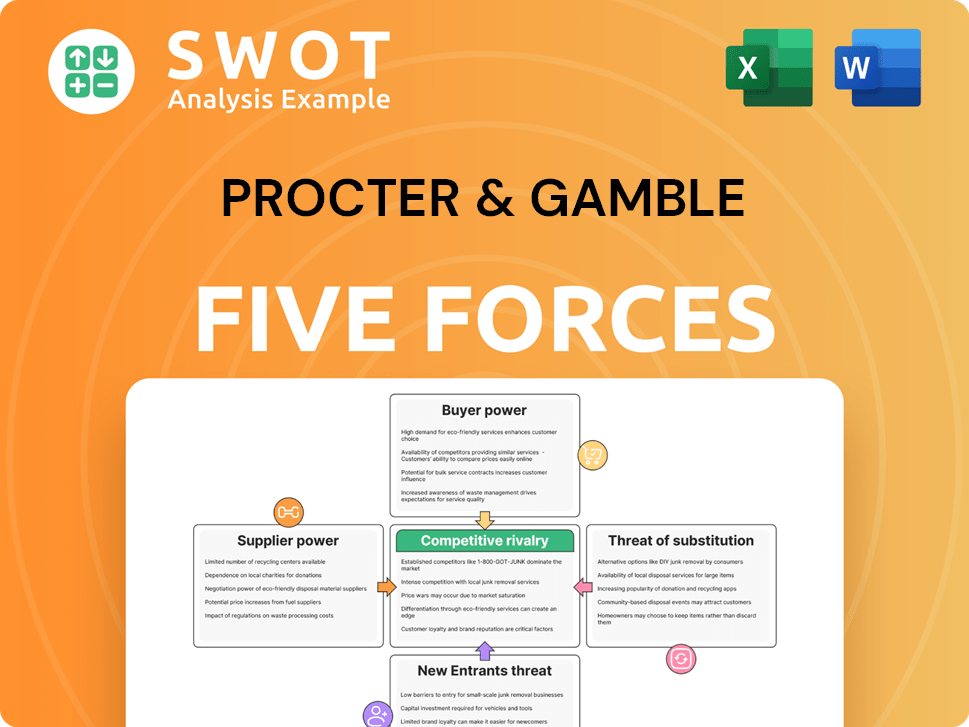
Related Blogs
- What are Mission Vision & Core Values of Procter & Gamble Company?
- What is Competitive Landscape of Procter & Gamble Company?
- What is Growth Strategy and Future Prospects of Procter & Gamble Company?
- What is Sales and Marketing Strategy of Procter & Gamble Company?
- What is Brief History of Procter & Gamble Company?
- Who Owns Procter & Gamble Company?
- What is Customer Demographics and Target Market of Procter & Gamble Company?
Disclaimer
All information, articles, and product details provided on this website are for general informational and educational purposes only. We do not claim any ownership over, nor do we intend to infringe upon, any trademarks, copyrights, logos, brand names, or other intellectual property mentioned or depicted on this site. Such intellectual property remains the property of its respective owners, and any references here are made solely for identification or informational purposes, without implying any affiliation, endorsement, or partnership.
We make no representations or warranties, express or implied, regarding the accuracy, completeness, or suitability of any content or products presented. Nothing on this website should be construed as legal, tax, investment, financial, medical, or other professional advice. In addition, no part of this site—including articles or product references—constitutes a solicitation, recommendation, endorsement, advertisement, or offer to buy or sell any securities, franchises, or other financial instruments, particularly in jurisdictions where such activity would be unlawful.
All content is of a general nature and may not address the specific circumstances of any individual or entity. It is not a substitute for professional advice or services. Any actions you take based on the information provided here are strictly at your own risk. You accept full responsibility for any decisions or outcomes arising from your use of this website and agree to release us from any liability in connection with your use of, or reliance upon, the content or products found herein.